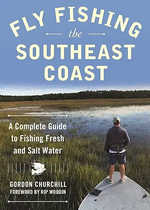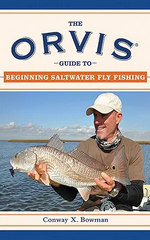Anyone starting out in this sport today will be confronted with a huge assortment of equipment to choose from. Most of it is very good. Quite a bit of it is excellent. And sadly, some of it is junk. With that said, we all have budgets to contend with. Some few of us have budgets that are unlimited. The majority of us don’t. Before I go any further, let me throw in one very important variable. And that is, your commitment to the sport. By that I mean that if you are thinking about starting to fish with a fly rod, you probably won’t want to spend a lot of money on equipment that you may wind up sticking in a closet or selling on E Bay. If, on the other hand, you have spent some time fly fishing and really want to pursue it, then by all means buy the best tackle that you can afford.
So here goes.
RODS
I bought my first fly rod in 1963 with money earned from my paper route, and I still have it. It’s an 8 ½ foot Shakespeare Wonder Rod marked for an HDG line. (Lines weren’t sold in standard weights like we see today until several years later.) In it’s day, this was the cat’s ass of fly rods. Top of the line. What set it apart from most other fiberglass rods built back then was that it was made using “the Howald Process”. Fiberglass strips were wrapped around a metal mandrel in much the same way that graphite rods are made today. This resulted in a hollow rod. Most other fiberglass rods of that era were solid. Those solid blanks were no different than the blanks used for most spinning rods. That Shakespeare rod, in its day, was considered to be light and responsive. If I let you cast a little with it today, you would think that it has all of the sensitivity of a mason’s hammer. And you would be right.
The point of this historical footnote is that even the majority of the least expensive beginners outfits on the market today are far superior to what many of us learned on back in what seems now like the early Pleistocene Epoch. I just checked a Cabela’s catalog and saw that they sell a complete beginner’s outfit for $180. That’ a rod, reel, line, leader, backing, flies and a few tools. If you want to give the sport a shot, an outfit like this is for you. On the other hand, if you are an intermediate fly fisher, like most of us, and you want to upgrade from your starter outfit, then look at mid-priced rods. There are many, many very good fly rods sold today by makers like Orvis, St. Croix, Temple Fork Outfitters, Scott, Sage, G. Loomis and Echo, just to name a few, in the $300 to $500 range that will accommodate you for years of fishing and learning. High end rods aren’t really necessary unless you are a gear junkie who won’t settle for anything but the best. Many of those mid priced rods are far better than top of the line rods were 20 years ago.
With that said, if you plan to only own one freshwater rod, and you plan to travel with it, then my recommendation would be to buy a 4 piece, 6 weight rod of either 8 ½ or 9 foot length. This will handle any trout fishing you might do in the lower 48, and pond fishing for pan fish and most bass. It’s a little light for big bass or pike, but if those species aren’t your primary target, it’ll be fine. If you plan to do a lot of bass fishing, steelhead fishing or maybe make an annual trip to Alaska for big rainbows, then a 7 weight rod would be better. Of course, you can always buy one of each. The War Department might not like it, but she’ll eventually calm down.
For saltwater, an 8 or 9 weight rod of 9 or 9 ½ feet is a good bet. The 8 will handle most redfish and bonefish. Get a 9 for big bull reds, permit, tarpon or stripers.
REELS
When I started fly fishing the prevailing thinking was that a fly reel mainly existed to hold your fly line. Most reels only had click drags. High end English reels, like the Hardy reel, had a click and pawl drag. Ted Williams, the Red Sox legend, caught more Atlantic Salmon than most of us will ever see in our lifetimes. If you look at old pictures of him holding those fish you’ll notice that he often used a Pfleuger Medalist reel. I still have a couple of those reels, which in their day cost about $30 and had a very primitive (by today’s standards) drag system. They’ll still handle any trout that I might be able to hook. Looking through the average fly fishing catalog reel section will take your breath away. I have paid less for new outboard motors than some of these reels cost. They are exquisite pieces of equipment with silky smooth drag systems that can probably stop a Prius in its tracks. For most fresh water fishing, and Eastern trout fishing in particular, these reels are totally unnecessary. However, with that said, if you plan to fish for salmon, steelhead, or those big Alaskan rainbows, you are going to need a reel with a good drag. The same goes for saltwater, because the fish are heavy and tough.
If you want a freshwater fly reel with a decent drag system and don’t want to spend a lot of money, then in my opinion, the best deal on the market today is the Orvis disc drag reel. For saltwater, buy the best reel that you can afford, because if you take care of it, your grandkids will be using it to catch fish long after you head west. Otherwise, any of the reels on the market today in the $50 to $100 range will work just fine. Because most of the time, it’s only going to be used to hold your fly line. One caveat, though. Be sure that whatever reel you buy has extra spools available for purchase. In the next section, I’ll explain why.
FLY LINES
Fly lines come in a bewildering array of types. Some float, some sink, and some float with sinking tips. If you plan to fish in places like ponds or big rivers where you have room to make a backcast, then get a weight forward floating line. On the other hand, if you plan to mainly fish smaller streams where roll casting will be the norm, then consider getting a double tapered floating line. The double taper was the standard fly line back in the day. Many people today have never used one. But for roll casting, they are tops. Sinking lines are specialty items that are very useful if you’re fishing big rivers or lakes with streamers. Sinking lines are almost always of weight forward configuration and come in different sink rates. For most streamer fishing, a Type II or III is fine. Intermediate lines, sometimes called Type I sinking lines, are very slow sinking lines that work very well for fishing small nymphs or wet flies just under the surface. They work great in ponds and lakes or for fishing wet flies or streamers over pools with weed beds. One last thing. The fly rod is a very versatile fish catching tool. With the right lines and flies, you can catch fish from the top to the bottom of the water column. This is where the extra spools come in. When I travel to fish for trout, I usually pack a 6 weight rod with a reel and 5 extra spools. That means 6 different lines – a weight forward floating line, a double tapered floating line, a weight forward intermediate line, and 3 weight forward sinking lines, Types II, III and IV. This sounds extreme, and probably is, but the extra spools take up very little space and the different line types allow me to do pretty much everything with that one outfit. Very often, changing lines of different sink rates will get you into fish when they’re eating down deep. This is especially true when fishing cold water in the early spring or fall, when the fish are sluggish and aren’t feeding near the top
Article written by Joe Rinaldi



